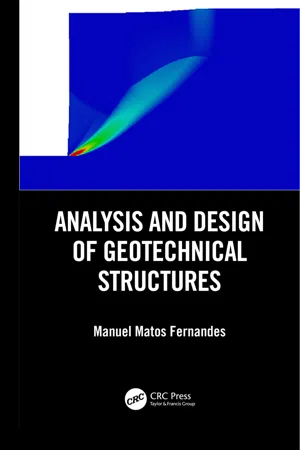
- 732 pages
- English
- ePUB (mobile friendly)
- Available on iOS & Android
Analysis and Design of Geotechnical Structures
About this book
Analysis and design of geotechnical structures combines, in a single endeavor, a textbook to assist students in understanding the behavior of the main geotechnical works and a guide for practising geotechnical engineers, designers, and consultants. The subjects are treated in line with limit state design, which underpins the Eurocodes and most North America design codes.
Instructors and students will value innovative approaches to numerous issues refined by the experience of the author in teaching generations of enthusiastic students. Professionals will gain from its comprehensive treatment of the topics covered in each chapter, supplemented by a plethora of informative material used by consultants and designers.
For the benefit of both academics and professionals, conceptual exercises and practical geotechnical design problems are proposed at the end of most chapters. A final annex includes detailed resolutions of the exercises and problems.
Frequently asked questions
- Essential is ideal for learners and professionals who enjoy exploring a wide range of subjects. Access the Essential Library with 800,000+ trusted titles and best-sellers across business, personal growth, and the humanities. Includes unlimited reading time and Standard Read Aloud voice.
- Complete: Perfect for advanced learners and researchers needing full, unrestricted access. Unlock 1.4M+ books across hundreds of subjects, including academic and specialized titles. The Complete Plan also includes advanced features like Premium Read Aloud and Research Assistant.
Please note we cannot support devices running on iOS 13 and Android 7 or earlier. Learn more about using the app.
Information
Chapter 1
Geotechnical characterization
1.1 Introduction
- (i) the identification, in geological and geotechnical terms, of the sequence of layers or strata that may affect the behavior of the structure;
- (ii) the physical, mechanical, and hydraulic characterization of the soils that form these layers or strata;
- (iii) the characterization of water conditions in the ground.
1.2 Geotechnical investigation
1.2.1 Preliminary surface survey
1.2.2 Geophysical investigation
1.2.2.1 Introduction
- (i) the advent of “new” methods, such as the surface seismic wave method;
- (ii) the combination of conventional geomechanical in situ tests with geophysical methods (such as the seismic cone penetration test and the seismic flat dilatometer test);
- (iii) the comparative application of geophysical methods in the field and in the laboratory on samples under well-defined test conditions;
- (iv) the strong...
Table of contents
- Cover
- Half-Title
- Title
- Copyright
- Contents
- Preface
- Author
- 1 Geotechnical characterization: In situ testing
- 2 Overall stability of soil masses
- 3 Basis of geotechnical design
- 4 Consolidation theories and delayed settlements in clay
- 5 Earth pressure theories
- The leaning bell-tower of Pisa
- 6 Shallow foundations
- 7 Pile foundations
- 8 Earth-retaining structures
- 9 Stability and stabilization of natural slopes
- 10 Introduction to earthworks: Soil compaction
- References
- Final annex: Resolution of the exercises
- Symbols
- Index